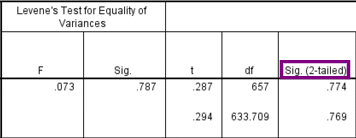Hypothesis Testing > Sig(2-Tailed)
You may want to read this other article first: One Tailed Test or Two in Hypothesis Testing. How to Decide.
Sig and Sig(2-Tailed) in Output
Output from some statistical software spits out Sig(2-Tailed) as part of the results for t-tests and correlations. Generally speaking, the “Sig” or “Sig(2-Tailed) is your p-value. The p-value has a slightly different interpretation depending on which test you’re running.

One Sample T-test
The Sig(2-tailed) item in the output is the two-tailed p-value. The p-value is the evidence against a null hypothesis. The smaller the p-value, the strong the evidence that you should reject the null hypothesis. If you have a small p-value in this area then the test has a significant result; You can reject the null hypothesis that the mean is not equal to a specified mean. A “small” p-value is one that is less than your chosen alpha level; If you didn’t choose an alpha level, then use 5% (0.05). The “specified mean” is the one you stated in the “hypothesized mean difference” box when you ran the test.
If the p-value is not small, then there is no difference in means and you can’t reject the null hypothesis.
This test has no direction — it’s simply telling you the mean isn’t equal to whatever number you typed in.
Paired T Test / Dependent Samples T Test
The Sig(2-tailed) entry is the two-tailed p-value. If you have a small value here (less than alpha), then there is a difference in means between the two sets of data.
This test has no direction.
Independent Samples T-test
The “Sig” entry in the output for independent samples is the two-tailed p-value for the null hypothesis that the two groups have the same variances. A small p-value indicates a difference in variances. If you have a significant result here, your data violates the assumption for equal variances. You cannot use the regular t-test; Use an alternative like Welch’s Test.
The Sig(2-tailed) entry is the two-tailed probability. If you’re using a one-tailed test, divide this value by two. A small p-value indicated the difference in means is not zero.
Correlations
The Sig(2-tailed) p-value tells you if your correlation was significant at a chosen alpha level. The p-value is the probability you would see a given r-value by chance alone. If your p-value is small, then the correlation is significant.